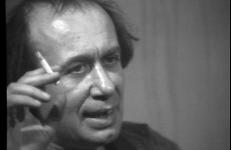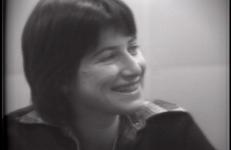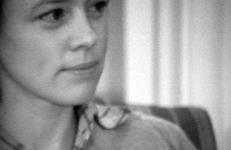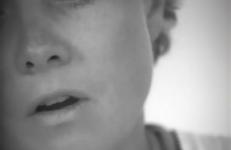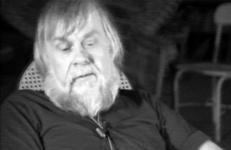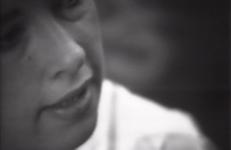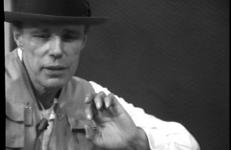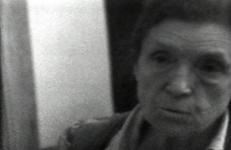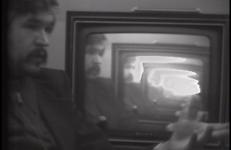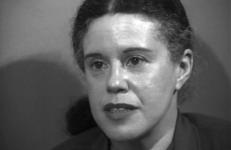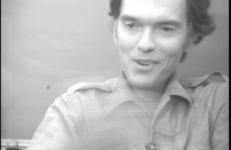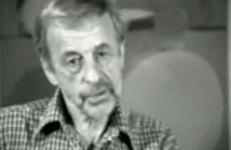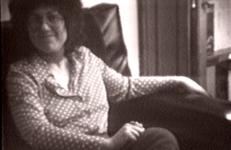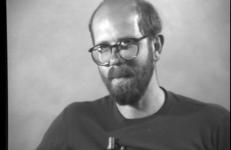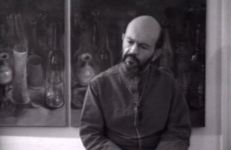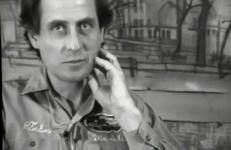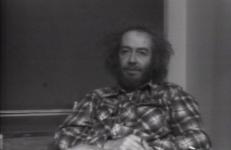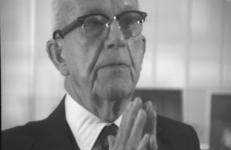Vito Acconci (b. 1940) is known as a conceptual designer, installation and performance artist. In the 1960s he embraced performance in order to "define my body in space, find a ground for myself, an alternate ground from the page ground I had as a poet." Acconci’s early performances, including Claim (1971) and Seedbed (1972), were extremely controversial, transgressing assumed boundaries between public and private space and between audience and performer.
Blumenthal/Horsfield Interviews
Chantal Akerman (1950-2015) gained international recognition with her three-and-a-half hour masterpiece, Jeanne Dielman, 23 Quai du Commerce, 1080 Bruxelles (1975), which portrays a housewife’s dull existence and eventual violent action. She has continued to be one of Europe’s most innovative filmmakers with more than forty film and television projects to her credit. Akerman’s work is minimalist, structuralist, and feminist. Major themes in her films include women at work and at home; women’s relationships to men, other women, and children; food, love, sex, romance, art, and storytelling. In this interview from 1976 Akerman discusses her early films, and the development of her particular vision.
Laurie Anderson (b. 1947) began her career as a gallery artist specializing in photography, before moving to critical work as a writer for Art News and Art in America. She later returned to the art world, making groundbreaking multimedia performance art. Her most widely known work dates back to the early-to-mid-’80s, and is marked by an innovative use of technology in blending media-based and staged performance.
Through her performances and videotapes, Eleanor Antin (b. 1935) creates characters (King, Ballerina, Black Movie Star, and Nurse) while spinning tales that blur fiction and history. She avoids good taste and flaunts concealed intentions, forcing one to stretch all possible associations to the breaking point.
“I believe interesting art has always been conceptual... that it appeals to the mind. That does not mean that it cannot seduce and attract through the eye,” Antin says in this interview with Nancy Bowen.
During her graduate studies at Hunter College, Alice Aycock (b. 1946) began to forge links between personal and more inclusive subject matter and form. In her quest for contemporary monuments, Aycock wrote her Master’s thesis on U.S. highway systems. Aycock’s large environmental sculptures create intense psychological atmospheres. Although she uses primitive rites and architecture as sources, her implementation of contemporary materials removes those specific connotations.
From his photo-text canvases in the 1960s to his video works in the 1970s to his installations in the 1980s, John Baldessari’s (b.1931) varied work has been seminal in the field of conceptual art. Integrating semiology and mass media imagery, he employed such strategies as appropriation, deconstruction, decontextualization, sequentiality, and text/image juxtaposition. With an ironic wit, Baldessari's work considers the gathering, sorting, and reorganizing of information.
Jennifer Bartlett (b. 1941) is a writer and painter who makes large paintings with enamels on fabricated panels. She uses an overall grid structure on which she repeats images in a variety of styles ranging from lyric abstraction to childlike representation. Near the end of this interview with Kate Horsfield, she reads the chapter “Dreaming” from her book The History of the Universe (1985). “I decided: 1) I didn’t want to stretch a canvas again, 2) I wanted to be able to work on a lot of things at once. I didn’t want to exercise my own taste, which seemed boring and hideous. I wanted something modular, a constant surface."
A historical interview originally recorded in 1976, edited in 2010 with support from the Lyn Blumenthal Memorial Fund.
Joseph Beuys (1921–1986) was born in Kleve, Germany. After serving as a volunteer in the German military, Beuys attended the Dusseldorf Academy of Art to study sculpture, where in 1959 he became a professor. Much of his artwork reflects his attempt to come to terms with his involvement in the war. During the ’60s, Beuys became acquainted with the group Fluxus and artists such as Nam June Paik.
Louise Bourgeois (1911–2010) utilized wood, metal, plaster, and bronze in creating her sculptures. Among the many themes in her work are the house (or lair), the spider and the so-called “toi-et-moi” or “you and me.” These subjects derived from a self-defined problem in Bourgeois’s life, the desire to find and express a means of getting along with other people. For Bourgeois, the relationship of one person to another was all-important, and life had little meaning without it. Louise Bourgeois’s remarkable career spanned both the modern and postmodern eras.
A major figure among underground filmmakers, Stan Brakhage (1933-2003) boasted a prolific career that spanned more than 50 years and 300 films. His personal, independent films range in length from nine seconds to several hours, and contemplate such fundamental issues as form, life, and death—most famously in Window Water Baby Moving (1959), Dog Star Man (1961-65), and The Act of Seeing with One’s Own Eyes (1971). His early writings and journals about filmmaking are collected in Metaphors on Vision (1976).
Phyllis Bramson (b.1941) is a Chicago painter whose post-imagist style emphasizes content and the deeply personal. Bramson’s paintings are private scenarios that include figures (or performers) who carry out highly charged activities with strong psychological meaning. They perform in highly theatrical, Oriental settings of almost cubist space and acid greens, yellows, and reds.
California-based painterJoan Brown (1938-1990) attended the California School of Fine Arts (now the San Francisco Art Institute). Brown has long been recognized as one of the most important artists to emerge from the creative milieu of the San Francisco Bay Area of the late 1950s. She created a body of work distinguished by its breadth and personal vision. Brown’s style incorporated abstract expressionism and figurative painting. One of California's pre-eminent figurative artists, she died in at the age of 52, in India.
Roger Brown's (1941-1997) quirky, stylized paintings were influenced by such disparate sources as comic strips, hypnotic wallpaper patterns, medieval panel paintings, and early works of Magritte. His work is epitomized by a series of claustrophobic urban scenes with their drop-curtain-like gray clouds and cardboard-box apartment buildings, suggesting an amalgamation of boyish enthusiasm for model making and adult despondency. In 1996 he donated his apartment, complete with all of his belongings, artworks, writings, and automobile to the School of the Art Institute in Chicago, where it is on public display.
Rudy Burckhardt (1914-1999) was best known as a photographer and filmmaker. He moved to New York from his native Basel in 1935 at age 21. He shot portraits of many artists for Art News during the 1950s and early ’60s, capturing their work methods in candid and intimate photos. His films, frequently portraying cityscapes and urban life, include The Pursuit of Happiness (1940), Under the Brooklyn Bridge (1953), What Mozart Saw on Mulberry Street (1956), Square Times (1967), and Inside Dope (1971).
Judy Chicago (b.1939) is an artist, author, feminist, educator, and intellectual whose career now spans four decades. In 1974, Chicago turned her attention to the subject of women’s history to create her best known work, The Dinner Party, which was executed between 1974 and 1979 with the participation of hundreds of volunteers. This monumental multimedia project, a symbolic history of women in western civilization, has been seen by more than one million viewers during its 16 exhibitions held at venues spanning six countries.
Judy Chicago (b.1939) creates large-scale, collaborative artwork has brought greater prominence to feminist themes and craft arts such as needlework and ceramics. Her most famous work, The Dinner Party (1979), was an enormous collaboration with hundreds of volunteers including ceramicists, china painters and needleworkers. The monumental finished piece has place settings for 39 mythical and historical famous women, writing them back into the heroic history usually reserved for men. Earlier in her career, Chicago was part of the Finish Fetish movement within Minimalism.
Chuck Close (b.1940) has been a leading figure in contemporary art since the early 1970s. As a young artist in the mid-’60s, Close turned away from the model of Abstract Expressionism to develop a simple but labor-intensive working method based upon repetition and small color elements. Denying himself expressive gesture, Close builds shapes and tonal variations within a working grid that provides the structure for large-scale, close-up portraits. Close’s formal analysis and methodological reconfiguration of the human face have radically changed the definition of modern portraiture.
A. D. Coleman started writing regularly on photography in 1967 for the Village Voice, at a time when very few critics took the medium seriously. His work, according to Joel Eisinger, qualified him as perhaps "the first postmodernist critic" in the field. After his tenure at the Voice, Coleman became the first photography critic at The New York Times, and has since published in numerous publications internationally on mass media, communication technologies, art, and photography.
Jim Dine (b. 1935) first emerged as an avant-garde artist creating Happenings and performances with Allan Kaprow, Claes Oldenburg, and others in the early 1960s. Ultimately, he rejected the performances that led to his early success in favor of an introspective search for identity. Using banal objects as subjects for his paintings and prints, Dine displayed a growing sense of self-awareness.
Rackstraw Downes’s “observation” paintings, executed on-site at ponds, intersections, and baseball parks, began as a mischievous response to the dogma of style and modernist criticism.
“There was a tremendous intellectual back-up, essentially against a lot of the figurative painting being done in the ’60s,” Downes says in this interview with Robert Storr. “If I show my slides in an art school I’ll get, 'Your paintings are very nice but how can you go backwards from Cézanne?’”
Eric Fischl's early works were large-scale abstract paintings. While teaching in Nova Scotia, Fischl began to shift from abstraction to smaller, image-oriented paintings, beginning with narrative works that investigated a fisherman's family. By the time Fischl left Halifax the narrative element was gone, but the subject of family melodrama remained. In the '80s Fischl's large figurative paintings, aggressive in their confrontation with the viewer, began to receive attention.
Louise Fishman (b.1939) is an abstract painter who uses knives rather than brushes to apply her undiluted colors. Her complex compositions place architectural shapes within other shapes.
“Almost everything is covered in my paintings. I go through numerous changes in them. I used to think that I was losing a lot of images. More recently I discovered that I was travelling through a process where an image would come back not exactly as it had been before. My unconscious memory is alive,” she says in this interview with Kate Horsfield.
Audrey Flack uses an airbrush to produce large photorealistic paintings and works from slides for her precision. She selects subjects with great personal significance that also represent fragments of contemporary American life. The three paintings discussed in detail in this tape are from the Vanitas series.
“Every still-life painter has her bag of tricks. You have your prop closet and just pull them out,” Flack says in this interview with Kate Horsfield. “One of the beauties of being an artist is that no one can tell me what to paint.”
In the 1960s and '70s, Hollis Frampton (1936-1984) emerged as one of the most important experimental filmmakers, creating structuralist works such as Zorns Lemma (1970), Poetic Justice (1972), and Nostalgia (1973).
Buckminster Fuller (1895-1983) was both a pioneer architect of the modern era and a global theorist. Fuller developed a system of geometry that he called “Energetic-Synergetic geometry,” the most famous example of which is the geodesic dome. His many designs for automobiles and living spaces were applications of a wider theory.




